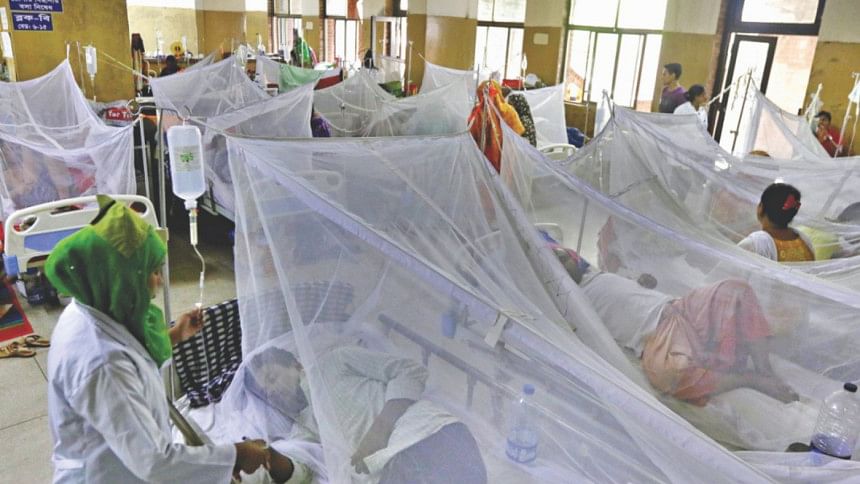A failure of prediction or policy?

The dengue epidemic in 2019 is eerily similar to the Hollywood movie The Edge of Tomorrow, where Tom Cruise, one of the main characters, becomes part of a time loop that forces him to fight against aliens in deadly combat again and again. Similarly, the dengue outbreak of 2019 forced Bangladeshi citizens to experience the vicious cycle of ineffective public policy, negligence by government officials and an inadequate and unprepared health system. Unfortunately, in this case, there is no Tom Cruise with superpowers to swoop in and save us from the mosquito menace.
In 2019, some 101,354 people were hospitalised with dengue in Bangladesh. Of them, 101,037 made full recovery. The government confirmed deaths of at least 164 people.
So what led to this nation-wide outbreak of dengue and what lessons had we learned from it? First and foremost, the early signals of dengue were ignored by the officials. Researchers from the Institute of Epidemiology, Disease Control and Research (IEDCR), a quasi-government research agency, had warned public officials about a possible dengue outbreak around the beginning of 2019. Even when a surge in dengue cases were making news headlines, the urgency of the situation was downplayed. Eventually, the High Court had to step in and criticised the two Dhaka City Corporations for their failure and directed them to take immediate actions. Unfortunately, it was already too late. By then, the high demand for hospital beds, the lack of dengue testing kits and effective insecticides, misinformation in social media and pervasive panic among people led to the collapse of the health system.
A recently published article in The Atlantic pointed out a similar pattern in this year's coronavirus epidemic where the Chinese government denied the initial outbreak that led to an exponential rise in cases, triggering panic among people and consequently a major epidemic all across the globe.
Sadly, the handling of infectious disease is marked by such patterns of denial, panic and mismanagement. In 2000, during one of the first major dengue outbreaks, officials in Bangladesh were initially in denial and later tried to cover it up by making false reassurances, and ultimately failed to prevent corruption and misuse of government funds and to provide adequate support to the patients.
Similar to dengue, other mosquito-borne infectious diseases (e.g. malaria, Chikungunya) are major public health issues; nonetheless, there is a lack of coordinated action plan from the Bangladesh government. Every year, there are thousands of malaria cases, with more than 17 million people at risk. For a country with a long history of malaria, one would expect that the health authorities have an integrated, digital surveillance system that monitors all mosquito-borne diseases.
Yet that is clearly not the case, and government policies and action plans are still fragmented and mostly reactive. During the Chikungunya outbreak in 2017, the government agencies failed once again to understand and acknowledge the gravity of the situation. There were more than 13,000 clinically confirmed cases between April 1, 2017 and September 7, 2017, according to the Ministry of Health.
In 2018, the Communicable Diseases Prevention, Control and Eradication Bill was passed in parliament in order to repeal and merge some of the dated laws and ordinances regarding infectious disease control, including the Epidemic Diseases Act (1897), the Public Health (Emergency Provisions) Ordinance (1944), the Bangladesh Malaria Eradication Board Ordinance (1977) and the Prevention of Malaria (Special Provisions) Ordinance (1978). This initiative, enacted with good intentions, provides some system-level direction in disease management. However, it falls short of clarifying the roles and responsibilities of various government authorities and developing strategies to respond.
During any outbreak, the expectation from health authorities is to become nimble and have the ability to act quickly. Instead of focusing on rapid response, however, the legislation created a bureaucratic hodgepodge of protocols and administrative processes which diminishes the ultimate effectiveness of such a law. Most importantly, it fails to strike a balance between the coercive measures imposed on citizens and businesses, and the expected public health outcome. The delayed and haphazard actions by local authorities (e.g. mobile court, use of insecticides) were perceived as an eyewash attempt. Such policies and actions create further tension and mistrust between the government and civil society, and ultimately put the marginalised members at higher risk of both harassment and disease burdens.
Already, 246 dengue cases have been reported between January 1 and March 4 this year, according to the Directorate General of Health Services (DGHS). This warrants both short and long-term measures from the government. One of the major risk factors for any mosquito-borne infectious disease is the mosquito breeding sites. Control of diseases such as Chikungunya, dengue and malaria requires efficient public policies and coordinated efforts from different levels of government, communities, and the citizens. Social-media-based monitoring of mosquito breeding grounds through mobile phone apps can gamify and incentivise citizens to detect "hot spots".
In addition to awareness campaigns, local and central health authorities should make conscious efforts to involve the civil society in the design, development, delivery, surveillance and continuous evaluation of public health policies. This way, Bangladesh can once again lead by example in terms of public health achievements (like the successful reduction in malnutrition and child mortality rates) and build capacity to reach the full potential of Digital Bangladesh.
Fahim Hassan, Nafis Hasan, and Syed Arefinul Haque are from University of Alberta, Canada, Tufts University, USA, and Northeastern University, USA, respectively.

 For all latest news, follow The Daily Star's Google News channel.
For all latest news, follow The Daily Star's Google News channel. 



Comments